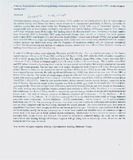| dc.description.abstract | Although common octopus, Octopus vulgaris (Cuvier, 1797), catches are increasing globally, lack of information on
the species biology and fishery has been a major concern in its management particularly in Kenya. Currently, the
common octopus has been listed within the "Endangered Status" IUCN 2010 List of Threatened Species. The
present study aims at investigating the fishery, reproductive and feeding biology of Octopus vulgaris from Shimoni
and Yanga which are some of the major fish landing sites in the Kenyan South coast. Sampling was done monthly
from November 2010 to November 2012 using traditional fishing spear 'rnkuki ' or 'shomo'. For each specimen
body weight (BW), total length (TL), dorsal mantle length (DML), ventral mantle length (YML) and gonad weights
were recorded. Maturity stages and Gonadosomatic Index (GSI) were determined using standard methods. Stomach
content analysis was determined using both the frequency of occurrence method and the dominant (numerical)
method. For the processing and markets of common octopus, information was collected from logbook records, and
landings from fishermen and fish industries. | en_US |

